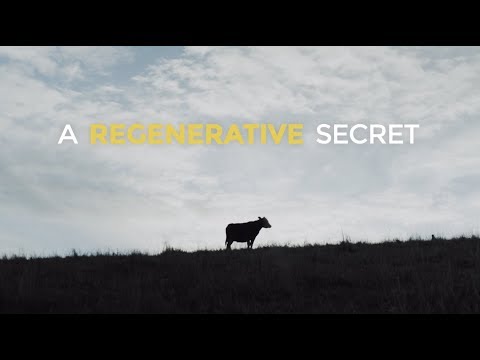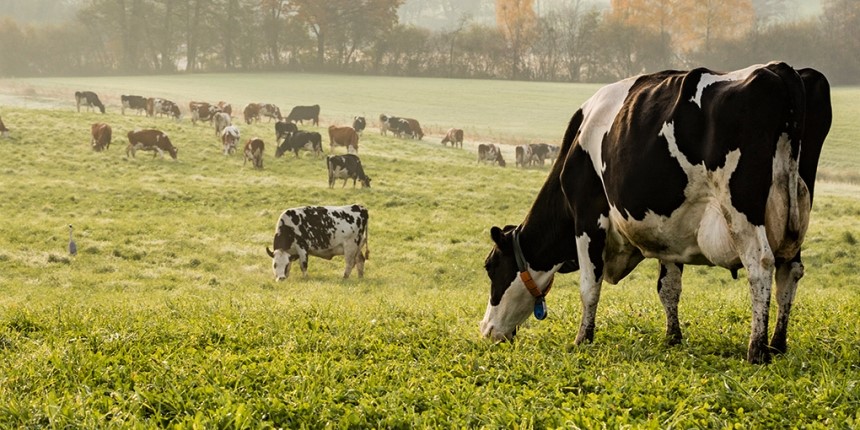Carry Kim speaks with Doug Lindamood, from SonRise Ranch in San Diego County, California. He and his family own and operate this pasture based livestock operation dedicated to changing industrial, factory farming into a local, sustainable, integrity, food movement through education and outreach one family at a time. According to SonRise Ranch, Management Intensive Grazing, regenerative agriculture, and the highest standards of animal husbandry are the best way to heal the planet.
Subscribe to EcoJustice Radio: Apple Podcasts | SoundCloud | Google | Spotify
Four-Legged Portable Carbon Sequestration Machines
By Doug Lindamood, at SonRise Ranch
Atmospheric carbon is produced by a number of processes, the foremost of which is the burning of fossil fuels. This creates pollution and is damaging to our entire Earth ecosystem. Carbon may be sequestered, or stored inside the ground. Carbon is primarily sequestered in the soil by plants of all types. Carbon is sequestered in the soil by nature with glue like protein called glomalin. Glomalin fastens carbon to soil so that it does not wash or blow away (it makes soil sticky, and clump together). Glomalin is a glycoprotein that looks like honey under a microscope. Glomalin was discovered in 1996 by Sara Wright and Kristine Nichols, two USDA research scientists. Glomalin is believed to make up approximately 15-20% of total soil organic matter.
Arbuscular Mycorrhizal Fungi is where glomalin is manufactured. The Arbuscular Mycorrhizal Fungi envelopes plant roots with hair like filaments called hyphae. These hyphae reach out and conduct “middle man” transactions with the surrounding soils, by trading carbon with nutrients essential for the plant’s survival.
STORY: Regenerative Responses: Growing The Soil Carbon Sponge

Watch this video on YouTube
A Regenerative Secret is a mini-documentary that contrasts the catastrophe of the current cattle industry with Regenerative Ranching, which includes restoring ecosystems, absorbing carbon and moisture into soils, which builds watersheds and water sustainability.
This two way exchange – nutrients to the plant, carbon to the soil is sole function of glomalin. Glomalin is a carbon based molecule, Arbuscular Mycorrhizal Fungi is a Carbon based life form, and both depend on Carbon for survival. It is best to think of carbon is the legal tender and Arbuscular Mycorrhizal Fungi as the exchange broker. The plant uses carbon to purchase nutrients from the Arbuscular Mycorrhizal Fungi, then the Arbuscular Mycorrhizal Fungi trades the carbon for nutrients from other microorganisms in the soil, that then use the carbon to feeding enzymes that then release more bound up nutrients from within the surrounding minerals – all the while, the carbon is captured deep in the soil, or literally, sequestered.
Glomalin coats the threads of the plant’s filaments roots, and protects them. Because glomalin is sticky, it aids in making soil clumps and promotes soil health. This aggregation of soil into “chunks” also helps with water infiltration, which in turn aids in mineral release and furthers the whole symbiotic process. Aggregation also helps stabilize the humus and protects it from degradation. Carbon stored in this form is twice as stable as its above ground counterparts stored in the leaves and stems of the plants mainly due to a lack of disturbance (the wind and animals move plants above ground releasing carbon, but rarely below).
There are two things that can destroy Arbuscular Mycorrhizal Fungi: First, tillage, physically tears Arbuscular Mycorrhizal Fungi networks apart and breaks down their structure, by damaging the hyphae. This limits glomalin because the Fungi must spend precious resources repairing their hyphae networks rather than extending them.
Synthetic fertilizers, such as phosphorus also damage Arbuscular Mycorrhizal Fungi networks because phosphorus is a key component used for trade by the Fungi in exchange for carbon with the surrounding soils. When synthetic phosphorus fertilizer is used in soils (P), the plant will switch its allegiance to the synthetic phosphorus rather than exchanging it with the Fungi, thus effectively leaving the Fungi without a purpose.
Native soils have very high levels of glomalin due to extensive networks of Arbuscular Mycorrhizal Fungi networks and thus store large amounts of carbon. Carbon sequestration is progressively less effective in the following order; Perennial Pasture (grassland), Forests and finally, Silvopastures (savannah grasslands dotted with trees)
Grasslands store the most, because the have a greater root surface area than large trees. Annual crops can store carbon using Arbuscular Mycorrhizal Fungi networks and glomalin, but rarely are they found without synthetic fertilizers, so they are highly ineffective as a tool to combat climate change. Additionally, they only live for a portion of the year, whereas, perennial grasslands live year round.
It is for this reason that pasturing livestock is the best possible way to store carbon. Pasture based herbivores disturb the soil surface, but only gently, allowing for water to infiltrate, but with limited disruption of the Arbuscular Mycorrhizal Fungi network. In addition to this, they add nutrient rich manure to the soil. They speed the breakdown of organic matter, by trampling dead and dying stems and leaves to feed the humus giving the surrounding soil something to trade with for more carbon. This then, causes the plant to thrive as it exchanges more carbon for more nutrients – and the cycle continues.
In the absence of large, well managed herbivore animals the whole ecological process moves in retrograde. The soil surface forms a “crust”, which water cannot penetrate causing water to run off taking valuable topsoil in the process. Worse, plants grow large, once then cannot decay quickly enough to expose the lower level plant life to growth promoting sunlight and water, thus inhibiting biodiversity. Woody brush and tap root forbs take over and shade out the grass, slowing the carbon cycle and sequestration.
Some profess, that to stop climate change we must remove cattle (the only remaining large herbivores in significant numbers) from pastures and, that we should harvest protein (via heavily industrialized mechanization) from plant based sources, such as soy and peas – both annual crops that require tillage and fertilizers. One can easily see the flaw in this model, as this would inhibit greatly the production of glomalin and the storage of already enormous amounts of carbon in the atmosphere.
SonRise Ranch: http://son-riseranch.com/
https://www.son-riseranchstore.com/Default.asp
Interview by Carry Kim
Hosted by Jessica Aldridge from SoCal 350 and Adventures in Waste.
Engineer: Blake Lampkin
Executive Producer: Jack Eidt
Show Created by Mark and JP Morris
Music: Javier Kadry
Episode 35
Photo courtesy of American Dairymen
Updated 18 December 2023










Pingback: Creating Resilient Ecosystems & Regenerating the Planet | WilderUtopia.com
Pingback: From Desert to Pasture: A Regenerative Ranching Tale - WilderUtopia